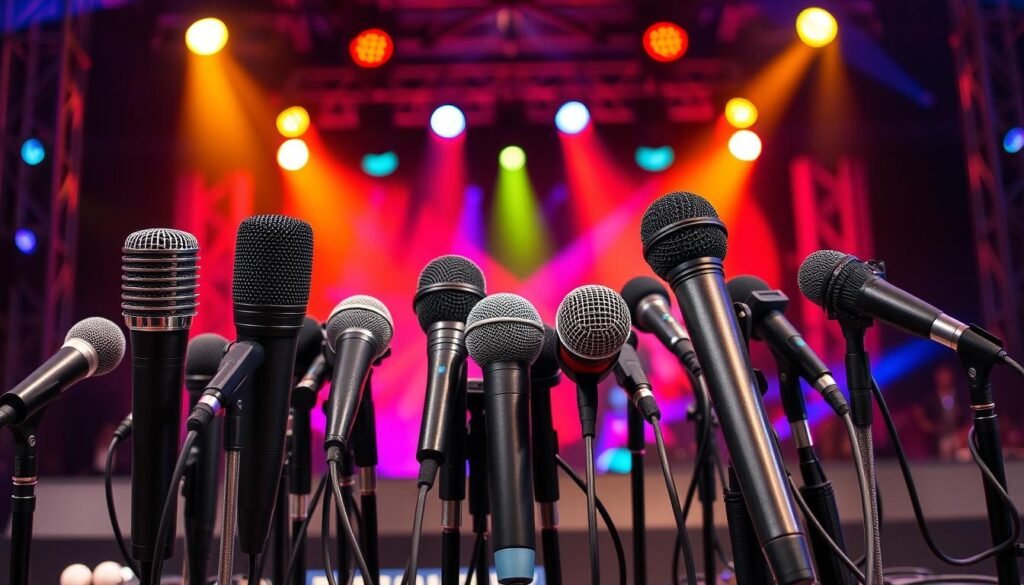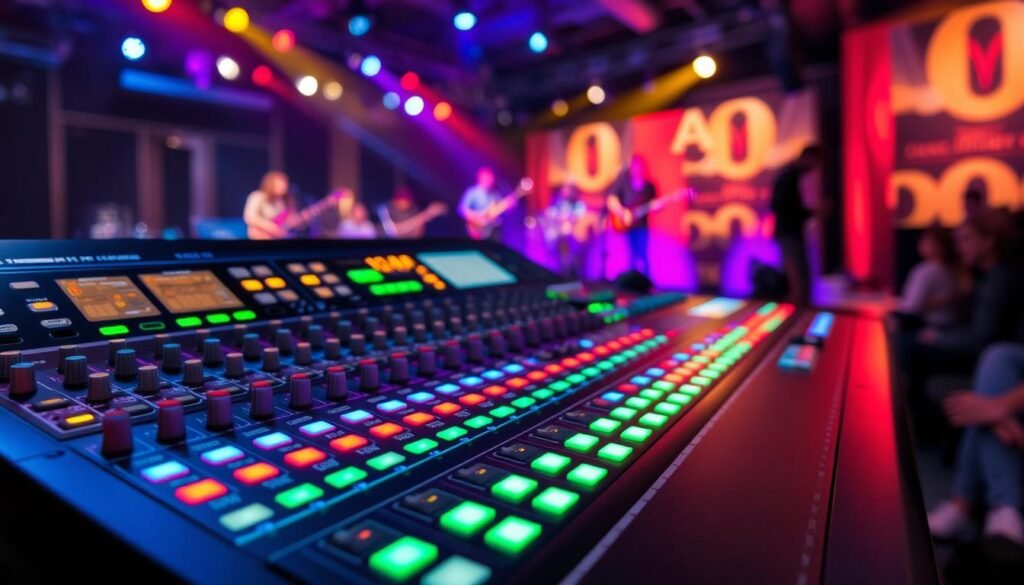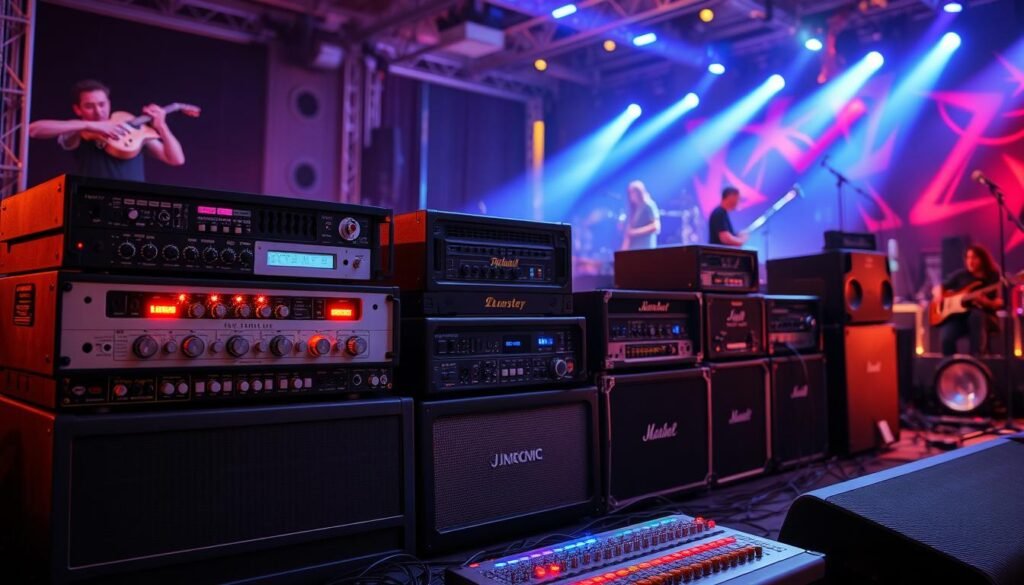ציוד אודיו מקצועי חיוני לחוויות קונצרט מעולות. מערכות חיזוק קול מבטיחות שמע ברור לכל חבר בקהל. ציוד לביצועים חיים כולל רכיבים שונים, כל אחד משרת מטרה ספציפית.
נבחן את הציוד החיוני למערכת קול חיה מקיפה. מיקרופונים תופסים פרטיות קול וכלי נגינה. מיקסרים מאפשרים שליטה מדויקת על הערבוב האודיו.
מגברי כוח מניעים רמקולים, מספקים שמע ברור ומשפיע לקהל. סוגי רמקולים שונים מיועדים לצרכי שמע שונים.
אביזרים משלימים הגדרת קול חיה. כבלים, מחברים, עמדות ומקרים מבטיחים חיבור ציוד תקין והגנה. רכיבים אלה מאפשרים ביצועים חלקים ואמינים.
הבנת כל רכיב מסייעת למקצוענים לקבל החלטות מושכלות. הידע הזה חיוני לבחירה והגדרת מערכות חיזוק קול. זה ערך עבור מהנדסים מנוסים ואהבי אודיו כאחד.
מסקנות עיקריות
- ציוד צליל חי הוא חיוני למסירת אודיו באיכות גבוהה בקונצרטים ואירועים.
- ציוד אודיו מקצועי כולל מיקרופונים, מיקסרים, מגברי כח, ורמקולים.
- מערכות חיזוק צליל דורשות בחירה והגדרה זהירה של כל רכיב.
- אביזרים חיוניים כמו כבלים, עמדות, ומזוודות מבטיחים חיבור תקין והגנה.
- הבנת התפקיד של כל רכיב היא קריטית להשגת איכות צליל אופטימלית.
הבנת היסודות של מערכות צליל חי
מערכות צליל חי מעולות הן קריטיות לקונצרטים ואירועים מדהימים. הן מבטיחות זרימת אודיו חלקה ומספקות צליל באיכות גבוהה לקהל. בואו נכיר את החלקים העיקריים של הגדרת צליל חי טיפית.
המיקסר הוא הלב של כל מערכת צליל חיה. הוא מעבד ומנתב את האותות האודיו. מהנדסי צליל משתמשים בו כדי להתאים רמות, להחיל אפקטים, ולאיזון הצליל הכולל.
מיקרופונים וכלי נגינה מתחברים למיקסר. הם ממירים גלי קול אקוסטיים לאותות חשמליים לצורך עיבוד והגברה.
האותות המעובדים עוברים מהמיקסר למגברי כוח. אלו מחזקים את עוצמת האות כדי להניע רמקולים. מגברי כוח מבטיחים שהקול מגיע לכל הקהל במספיק עוצמה ובבהירות.
האותות המוגברים ממשיכים לרמקולים ראשיים, רמקולים למוניטור וסאבוופרים. כל אחד משמעותו תפקיד ספציפי בחיזוק הקול.
"מערכת סאונד חיים שמעוצבת היטב היא כמו כלי נגינה ממוקד, המאפשר לביצוע האמן לזוז עם בהירות והשפעה." – מהנדס סאונד מוכר, כריס ג'ונסון
בחירת רכיבי מערכת הסאונד הנכונים חיונית לזרימת קול חלקה. יש לשקול את גודל האולם, סוג ההופעה ורמת השליטה הרצויה. יש לבחור בקפיצי צליל, מיקסרים, מגברים ורמקולים שעובדים יחד בצורה טובה.
הגדרה טובה מספקת איכות צליל מעולה. זה משפר את חוויית הקהל באירוע שלך.
| רכיב | מטרה |
|---|---|
| מיקרופונים | ללכוד צליל מכלי נגינה ושירה |
| מיקסר | לעבד ולהפנות אותות אודיו |
| מגברי כח | להגביר את עוצמת האות כדי להניע רמקולים |
| רמקולים | להמיר אותות חשמליים לגלי צליל |
בשלב הבא, נבחן כל רכיב במערכת הסאונד החי בפרט. נבחן את התכונות, היתרונות והתפקיד של כל רכיב ביצירת חוויות שמע מוקפות.
מיקרופונים: לתפוס את הסאונד המושלם
מיקרופונים הם חיוניים לתפיסת קולות וכלי נגינה בהגדרות סאונד חי. בחירת הנכונים מבטיחה איכות ובהירות לביצוע שלך. קיימים מספר סוגים, כל אחד עם תכונות ויתרונות ייחודיים.

מיקרופונים דינמיים
מיקרופונים דינמיים הם חזקים ומתמודדים טוב עם רמות לחץ סאונד גבוהות. הם מצוינים לתופים, מגברי גיטרה וכלי נגינה מתכתיים. ה-Shure SM57 וה-SM58 פופולריים בזכות העמידות שלהם.
למיקרופונים אלו עיצוב פשוט עם קור שנע צמוד לדיאפרגמה. גלי קול גורמים לדיאפרגמה לרעוד, מזיזים את הקור בשדה מגנטי. זה יוצר אות חשמלית.
מיקרופונים דינמיים פחות רגישים לתדרים גבוהים ומתנגדים לפידבק בצורה טובה יותר מסוגים אחרים.
מיקרופונים קונדנסר
מיקרופונים קונדנסר מציעים רגישות ובהירות מעולות. הם אידיאליים לשימוש בשירה ובכלי נגינה אקוסטיים בהופעות חיות. מיקרופונים אלו מכילים דיאפרגמה דקה ומטעה שמרטטת עם גלי קול.
מיקרופונים קונדנסר דורשים כוח פנטום כדי לפעול. הם רגישים יותר לתדרים גבוהים ויש להם תגובת תדרים רחבה יותר. מודלים פופולריים כוללים את Neumann KMS 105 ו-Shure Beta 87A.
מערכות מיקרופון אלחוטי
מערכות אלחוטיות מאפשרות לבמאים לזוז בחופשיות על הבמה. הן מורכבות ממשדר ומקלט המחוברים לשולחן הערבות. מערכות אלו משתמשות בטווחי תדרים ספציפיים כמו UHF או VHF.
כאשר בוחרים מערכת אלחוטית, חשוב לשקול את מספר הערוצים, הטווח וזמינות התדרים. אפשרויות פופולריות כוללות את Shure ULX-D וסדרת Sennheiser ew 100 G4.
| סוג המיקרופון | תכונות | יישומים אידיאליים |
|---|---|---|
| דינמי | עמיד, יכול לטפל ברמות גבוהות של SPL | תופים, מגברי גיטרה, כלי נשיפה |
| קונדנסר | רגיש, ברור, תגובת תדר רחבה | שירה, כלי נגינה אקוסטיים |
| אלחוטי | חופש תנועה, דורש התקנה | שירה, כלי נגינה, הרצאות |
בעת בחירת מיקרופונים, חשוב לשקול את צרכי הכלי והשירה. כדאי להתייחס לתבניות פולאריות, שמשפיעות על איסוף הצליל מכיוונים שונים. תבניות קרדיואידיות נפוצות, והן דוחות צליל מהאחור.
תבניות סופרקרדיואידיות והיפרקרדיואידיות מציעות כיווניות גדולה ועמידות נגד משוב. השקעה במיקרופונים איכותיים חיונית לתפיסת צליל חי מושלם.
מיקסרים: הלב של ההתקנה שלך לצליל חי
מיקסרים חיוניים בהתקנות לצליל חי. הם מערבבים, מעבדים ומנתבים אותות אודיו ממקורות שונים. מיקסרים אנלוגיים ודיגיטליים כל אחד עם יתרונות ייחודיים.
הבנת התכונות המרכזיות חיונית. הידע הזה עוזר להשיג איכות צליל מבוקשת וגמישות. בחירת המיקסר הנכון חיונית לצרכי הצליל החי שלך.

מיקסרים אנלוגיים
מיקסרים אנלוגיים היו פופולריים למשך עשורים. הם מציעים מיקוש ידני עם בקרים פיזיים. מיקסרים אלו מכירים בצליל חם וטבעי.
מיקסרים אנלוגיים עוסקים ברמות סיגנל גבוהות ללא איכות תמונה. הם מספקים פריסה אינטואיטיבית ומשוב חזותי מיידי. אין טיהור או ארטיפקטים של עיבוד דיגיטלי.
- פריסה ובקרים אינטואיטיביים
- משוב חזותי מיידי של ההגדרות
- אין טיהור או ארטיפקטים של עיבוד דיגיטלי
- עמיד ואמין בסביבות חיוניות וחיוניות
מיקסרים דיגיטליים
מיקסרים דיגיטליים זכו לפופולריות בזמן האחרון. הם ממירים אותות אנלוגיים לנתונים דיגיטליים. זה מאפשר שליטה ועיבוד מדויק.
מיקסרים אלו מציעים תכונות מתקדמות וגמישות. הם קלים לשימוש ומספקים הרבה יתרונות.
- שמירה ושחזור הגדרות להגדרה מהירה
- אפקטים מובנים ועיבוד דינמי
- שליטה מרחוק דרך טאבלטים או סמארטפונים
- אינטגרציה עם רשתות שמע דיגיטליות
"מיקסרים דיגיטליים שינו את עיבוד הצליל החי, מציעים שליטה וגמישות ללא תקדים. עם היכולת לשחזר הגדרות ולגשת לכלים עיבוד חזקים, מהנדסים יכולים כעת ליצור מיקס מושלם בקלות." – שרה ג'ונסון, מהנדס צליל מקצועי
תכונות ושיקולים של המיקסר
כאשר אתה בוחר מיקסר, שקול את התכונות העיקריות הללו. הן יעזרו לך לבחור את הבחירה הכי טובה עבור ההתקנה שלך.
| תכונה | תיאור |
|---|---|
| ערוצי קלט | וודא שהמיקסר מציע מספיק ערוצי קלט כדי להתאים לכל מקורות השמע שלך, כגון מיקרופונים, כלי נגינה ומכשירי השמעה נוספים. |
| שיווק EQ ועיבוד אפקטים | חפש מיקסרים עם אפשרויות שיווק EQ ועיבוד אפקטים רחבות כדי לעצב ולשפר את האותות השמע שלך. EQ פרמטרי, עיבוד דינמי (דחיפה ושערוריה) ואפקטים מובנים כמו ריברב ודיליי הם חיוניים ליצירת מיקסים מטופחים. |
| אפשרויות ניתוב | שקול מיקסרים עם אפשרויות ניתוב גמישות, כגון שליחות עזר, קבוצות משניות ופלטות מטריצה. תכונות אלו מאפשרות לך ליצור מיקסים מותאמים אישית למוניטור, לנתב אותות ליחידות עיבוד חיצוניות ולהפיץ שמע לאזורים או רמקולים שונים. |
| ממשק משתמש ונוחות בשימוש | בחר מיקסר עם ממשק משתמש אינטואיטיבי ופריסת ממשק שמתאימה לזריזות העבודה שלך. שקול גורמים כמו גודל ומיקום של בקרים, איכות התצוגה וניווט בתפריטים כדי לוודא פעולה יעילה במהלך אירועים חיים. |
הבנת סוגי מיקסר היא חיונית. ערכו את צרכיכם הספציפיים בזהירות. זה יעזור לכם לבחור בצורה המושלמת את מערכת הערבוב השמע.
המיקסר הוא הלב של מערכת השמע החיה שלכם. השקיעו ביחידה אמינה ועשירת תכונות. זה יעזור לספק חוויות שמע מעולות לקהל שלכם.
מגברי כוח: מניעים את הצליל שלכם
מגברי כוח הם חיוניים להתקני שמע חיים. הם מחזקים את האותות ברמה נמוכה מהמיקסרים כדי להניע רמקולים. מגברים אלה מספקים צליל נקי וחזק לקהל.
כיתות מגברים מציעות יעילות ואיכות צליל שונה. שקלו את אלו בעת בחירת מגברי כוח למערכת שלכם.
- מגברי כיתה A ידועים באיכות הצליל הגבוהה שלהם, אך פחות יעילים ויוצרים יותר חום.
- מגברי כיתה B יעילים יותר ממגברי כיתה A, אך עשויים להכניס אי-סימטריה במעבר.
- מגברי כיתה AB משלבים את היתרונות של כיתה A ו-B, מציעים יעילות ואיכות צליל טובה.
-
סוגי מגברים D, הידועים גם כמגברים מתגים, הם יעילים ביותר וקלים, ולכן נהיים פופולריים למערכות סאונד ניידות.

אימפדנס רמקול חשובה בעת בחירת מגברי כוח. עליך להתאים את האימפדנס של הרמקולים שלך ליכולות המגברים שלך. זה מבטיח ביצועים אופטימליים ומונע נזק לציוד.
רוב הרמקולים המקצועיים מגיעים עם אימפדנס של 4 או 8 אום. ודא שהמגברים שלך תואמים את הערכים הללו.
"להתאמת יצוא הכוח של המגברים שלך לדרישות הרמקולים שלך היא מרכזית להשגת סאונד מאוזן וחזק מבלי לסכן את הציוד שלך." – שרה ג'ונסון, מהנדסת סאונד מקצועית
כוח המגבר
הוא עוד פרמטר מפתח שצריך לשקול. המגברים שלך צריכים להניע רמקולים בעוצמות הרצויות בלי קיפול או אי סדק.
בחר מגבר שמספק לפחות פי שניים את הכוח הרציף המדורג של הרמקולים שלך. זה מבטיח צליל נקי ולא מוטל בעיות.
| סוג מגבר | יעילות | איכות צליל | יצירת חום |
|---|---|---|---|
| סוג A | נמוך | גבוהה | גבוהה |
| סוג B | בינונית | בינונית | בינונית |
| סוג AB | בינונית עד גבוהה | גבוהה | בינונית |
| סוג D | גבוהה | בינונית עד גבוהה | נמוכה |
בחר את מגברי הכח הנכונים למערכת הסאונד החי שלך. שקול מחלקות מגברים, אימפדנסית רמקולים, וטווח וואט. זה מבטיח מסירת שמע ברור, חזק, ואמין.
הבחירה המקפדת שלך תיצור חוויה בלתי נשכחת עבור הקהל שלך. תהנה מהאיזון המושלם של בהירות וכוח בסאונד שלך.
רמקולים: מסירת שמע לקהל שלך
רמקולים ממירים אותות חשמליים ממוגברים לגלי קול לקהל. הם חיוניים למסירת שמע באיכות גבוהה למאזינים ולביצועים. הגדרה נכונה משקללת אזור כיסוי, דפוזיציות פיזור, ומיקום להפצת קול אחידה.
רמקולים ראשיים
רמקולים ראשיים, או רמקולי PA, מסירים שמע לקהל. הם מוצבים בצדדים של הבמה, מול המאזינים. רמקולי PA מגיעים בגדלים ותצורות שונות.
האפשרויות כוללות רמקולים טווח מלא או סאבוופרים נפרדים וארונות עליונים. הבחירה תלויה בגודל האולם ובצרכי האירוע. המיקום הנכון מבטיח כיסוי טוב וממזער נקודות מתים.
רמקולי מוניטור
רמקולי מוניטור מספקים צליל בבמה למבצעים. הם מונחים על רצפת הבמה, מול המוזיקאים. רמקולים אלו משתמשים בערבות מותאמות אישית לצרכי כל מבצע.
המיקום היעיל מבטיח שהמוזיקאים ישמעו את עצמם מבלי לגרום להפרעה לאחרים. מערכות מוניטורים באוזניים מציעות אלטרנטיבה עם בידוד צליל משופר וערבות אישית.
סאבוופרים
סאבוופרים מפיקים תוכן בתדרים נמוכים, בדרך כלל מתחת ל-100 הרץ. הם מוסיפים עומק ובס לצליל הכולל. סאבוופרים נפוצים מונחים על הקרקע, ליד רמקולים ראשיים.
אולמות גדולים עשויים להשתמש בסאבוופרים מרובים להפצה אחידה. אינטגרציה תקינה מתחשבת בתדר חיתוך, ביישור פאזה ובמיקום. זה מבטיח צליל מאוזן.
| סוג רמקול | מטרה | מיקום |
|---|---|---|
| רמקולים ראשיים (רמקולי PA) | מספקים שמע לקהל | בצדדים של הבמה, מול הקהל |
| רמקולי מוניטור (מוניטורי במה) | מספקים צליל במה למבצעים | על רצפת הבמה, מול המבצעים |
| סאבוופרים | משקיעים תוכן תדר נמוך | על הקרקע, מול או לצידי רמקולי הראשיים |
בחירת רמקולים דורשת לשקול את צרכי האירוע, גודל האולם והכיסוי הקולי הרצוי. בחירה זהירה של רמקולים ומיקום תקין מבטיחים איכות צליל גבוהה. הגישה הזו מועילה גם לקהל וגם למבצעים לאורך כל האירוע.
אביזרים חיוניים לציוד קול חי
מערכות קול חי דורשות יותר מרכיבים ראשיים בלבד. אביזרים מבטיחים פעולה חלקה ואמינה. כבלים, עמדות ומזוודות הם תוספות חיוניות.
כבלים וחיבורים
כבלי קול וחיבורים הם קריטיים להפניית האותות. חיבורי XLR משמשים למיקרופונים ולאותות קול מאוזנים. חיבורים בגודל 1/4 אינץ' נפוצים בכלי נגינה ובחיבורים לא מאוזנים.
כבלים באיכות גבוהה ממזערים את אובדן האות וההפרעה. תוצאת זאת היא ביצוע קולי נקי ואמין יותר. השקעה בכבלים איכותיים היא חיונית.
עמדות ותושבות
עמדות ותושבות מבטיחות מיקום אופטימלי של הציוד שלך. עמדות למיקרופונים עוזרות לזמרים ולנגנים לשמור על טכניקה נכונה.
עמדות רמקולים משפרות הפצת צליל וכיסוי של הקהל.
עמדות יציבות וניתנות להתאמה משפרות את המקצועיות. הן משפרות את היעילות של התקנת צליל חי שלך. המיקום התקין הוא מרכזי לביצוע איכותי.
מזוודות ותיקים
הגנה על הציוד שלך במהלך הובלה ואחסון היא חיונית. מזוודות ותיקים מציעות הגנה מרופדת נגד פגיעות, אבק ולחות. הן מיועדות לרכיבים שונים כמו מיקרופונים, מיקסרים וכבלים.
השקעה במזוודות איכותיות עשויה למנוע תיקונים יקרים. זה מבטיח שהציוד שלך תמיד מוכן להופעה הבאה. הגנה היא חיונית לאורך חיי הציוד.



